Important Questions for Class 12 Physics Chapter 8 Electromagnetic Waves Class 12 Important Questions
Electromagnetic Waves Class 12 Important Questions Very Short Answer Type
Question 1.
Name the part of the electromagnetic spectrum of wavelength 10-2 m and mention its one application. (Delhi 2008)
Answer:
Name of the part: Microwave
Applications :
- It is used in radar communication.
- It is used in microwave ovens.
- It is also used in analysis of fine details of molecular and atomic structure.
Question 2.
Write the following radiations in ascending order in respect of their frequencies ;
X-rays, Microwaves, UV rays and radiowaves. (Delhi 2009)
Answer:
Radiowaves, microwaves, UV-rays and X-rays.
Question 3.
Name the electromagnetic radiation to which waves of wavelength in the range of 10-2 m belong. Give one use of this part of EM spectrum. (Delhi 2009)
Answer:
Name : Microwave, Range 0.1 to 1 mm
Uses : Microwaves are used in aircraft navigation.
Question 4.
Name the part of electromagnetic spectrum which is suitable for
- radar systems used in aircraft navigation
- treatment of cancer tumours. (Delhi 2009)
Answer:
- Micro-waves
- Gamma-rays.
Question 5.
Name the EM waves used for studying crystal structure of solids. What is its frequency range? (All India 2009)
Answer:
X-rays frequency range : 1017 Hz to 1020 Hz
Question 6.
Which part of electromagnetic spectrum has largest penetrating power? (Delhi 2010)
Answer:
γ-rays are the electromagnetic waves of frequency range 3 × 1018 Hz to 5 × 1022 Hz and have the highest penetrating power.
Question 7.
Which part of electromagnetic spectrum is absorbed from sunlight by ozone layer? (Delhi 2010)
Answer:
Ultraviolet rays are absorbed from sunlight by ozone layers.
Question 8.
Which part of electromagnetic spectrum is used in radar systems? (Delhi 2010)
Answer:
Microwave region of electromagnetic spectrum is used in radar systems.
Question 9.
Name the part of electromagnetic spectrum whose wavelength lies in the range of 10-10 m. Give its one use. (All India 2010)
Answer:
Name : X-rays
Use : In medical diagnosis to look for broken bones; treatment study of crystal structure.
Question 10.
Which of the following has the shortest wavelength :
Microwaves, Ultraviolet rays, X-rays. (All India 2010)
Answer:
X-rays have the shortest wavelength.
Question 11.
Arrange the following in descending order of wavelength :
X-rays, Radio waves, Blue light, Infrared light. (All India 2010)
Answer:
Decreasing order ➝ Radio waves, Infrared light, Blue light, X-rays.
Question 12.
A plane electromagnetic wave travels in vacuum along z-direction. What can you say about the direction of electric and magnetic field vectors? (Delhi 2011)
Answer:
The direction of electric field vector is along X-axis. Magnetic field vector is along Y-axis.
Question 13.
A plane electromagnetic wave travels in vacuum along x-direction. What can you say about the direction of electric and magnetic field vectors? (Delhi 2011)
Answer:
The electric field and magnetic field vectors are in YZ-plane in the Y-direction and Z-direction respectively.
Question 14.
A plane electromagnetic wave travels in vacuum along y-direction. What can you say about the direction of electric and magnetic field vectors? (Delhi 2011)
Answer:
The electric field and magnetic field vector are in ZX-plane in the X-direction and Z-direction respectively.
Question 15.
How are radio waves produced? (All India 2011)
Answer:
Radio waves are produced by the accelerated motion of charges in conducting wires.
Question 16.
How are X-rays produced? (All India 2011)
Answer:
X-rays are produced by sudden deceleration or acceleration of electrons in an X-ray tube.
Question 17.
How are microwaves produced? (All India 2011)
Answer:
Microwaves are produced by Klystron valve or magnetron valve.
Question 18.
Name the physical quantity which remains same for microwaves of wavelength 1 mm and UV radiations of 1600 Å in vacuum. (Delhi 2012)
Answer:
Speed/Velocity of light remains the same.
Question 19.
What are the directions of electric and magnetic field vectors relative to each other and relative to the direction of propagation of electromagnetic waves? (All India 2012)
Answer:
The oscillations of
Question 20.
The speed of an electromagnetic wave in a material medium is given by
Answer:
Frequency remains unchanged.
Question 21.
A capacitor has been charged by a dc source. What are the magnitudes of conduction and displacement currents, when it is fully charged? (Delhi 2013)
Answer:
On full charging, the source will maintain the potential across the plates. The magnitudes of displacement current and conduction current will be zero.
Question 22.
Welders wear special goggles or face masks with glass windows to protect their eyes from electromagnetic radiations. Name the radiations and write the range of their frequency. (All India 2013)
Answer:
The name of radiations is ultraviolet radiation. Its frequency range is 1015 to 1017 Hz.
Question 23.
To which part of the electromagnetic spectrum does a wave of frequency 5 × 1019 Hz belong? (All India 2013)
Answer:
A wave of frequency 5 × 1019 Hz belongs to γ-rays region of electromagnetic spectrum.
Question 24.
To which part of the electromagnetic spectrum does a wave of frequency 3 × 1013 Hz belong? (All India 2014)
Answer:
Infra-red region of electromagnetic spectrum.
Question 25.
Why are microwaves considered suitable for radar systems used in aircraft navigation? (Delhi 2016)
Answer:
Due to their short wavelengths, microwaves are considered suitable for radar systems in aircraft navigation.
Question 26.
How is the speed of em-waves in vacuum determined by the electric and magnetic fields? (Delhi 2017)
Answer:
Speed of em-waves in vacuum is determined by the ratio of the peak values of electric and magnetic field vectors.
Question 27.
Do electromagnetic waves carry energy and momentum? (All India 2017)
Answer:
Yes, they do, because of change of magnetic flux associated with circular loop.
Question 28.
Write the relation for the speed for electromagnetic waves in terms of the amplitudes of electric and magnetic fields. (All India 2017)
Answer:
Question 29.
In which directions do the electric and magnetic field vectors oscillate in an electromagnetic wave propagating along the x-axis? (All India 2017)
Answer:
Electric field (
Electromagnetic Waves Class 12 Important Questions Short Answer Type SA-I
Question 30.
The oscillating magnetic field in a plane electromagnetic wave is given by
By = (8 × 10-6) sin [2 × 10-11 t + 300 π x] T
(i) Calculate the wavelength of the electo-magnetic wave.
(ii) Write down the expression for the oscillating electric field. (Delhi 2008)
Answer:
Given: By = 8 × 10-6 sin [2 × 1011 t + 300 π x] T
(i) Standard equation is,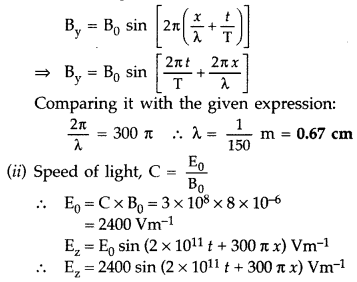
The oscillations of
Question 31.
The oscillating electric field of an electromagnetic wave is given by :
E = 30 sin [2 × 1011 t + 300 π x] Vm-1
(a) Obtain the value of the wavelength of the electromagnetic wave.
(b) Write down the expression for the oscillating magnetic field. (Delhi 2008)
Answer:
(a) We compare the given expression with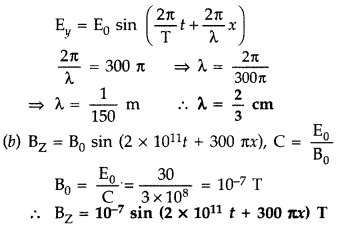
Question 32.
How does a charge q oscillating at certain frequency produce electromagnetic waves? Sketch a schematic diagram depicting electric and magnetic fields for an electromagnetic wave propagating along the Z-direction. (Delhi 2009)
Answer:
As the charge q moves accelerating, the electric field and magnetic field produced will change the space and time E and B varying with time produced the other field B and E respectively and sustain the E.M. pattern.
This is from the interpretation of Maxwell supported by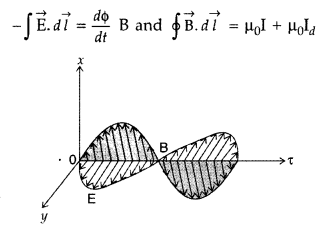
Question 33.
Arrange the following electromagnetic radiations in ascending order of their frequencies:
(i) Microwave
(ii) Radiowave
(iii) X-rays
(iv) Gamma rays
Write two uses of any one of these. (Delhi 2009)
Answer:
In ascending order of their frequencies :
Radiowave < Microwave < X-rays < Gamma rays.
Two uses of microwaves are :
1. In microwave ovens.
2. In aircraft navigation.
Question 34.
Draw a sketch of a plane electromagnetic wave propagating along the z-direction. Depict clearly the directions of electric and magnetic fields varying sinusoidally with z. (All India 2009)
Answer:
Sketch of a plane electromagnetic wave propagating along the z-direction with oscillating electric field E along the x-direction and the oscillating magnetic field B along the y-direction.
Question 35.
How are infrared waves produced? Why are these referred to as ‘heat waves’? Write their one important use. (Delhi 2009)
Answer:
Infrared rays are produced by hot bodies and molecules. This may involve vibration and bending of molecules. Infrared band lies adjacent to low-frequency or long-wavelength end of the visible spectrum. Infrared waves are sometimes referred to as heat waves.
Use: Infrared rays are used to take photographs in darkness. These are also used to study secret writing. They are also used in physical therapy.
Question 36.
A parallel plate capacitor is being charged by a time varying current. Explain briefly how Ampere’s circuital law is generalized to incorporate the effect due to the displacement current. (All India 2011)
Answer:
Maxwell’s displacement current : According to Ampere’s circuital law, the magnetic field B is related to steady current I as
Maxwell showed that this relation is logically in-consistent. He accounted this inconsistency as follows :
Ampere’s circuital law for loop C1 gives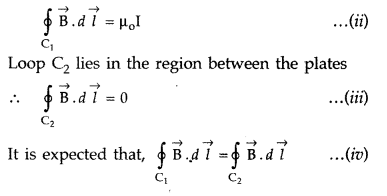
which is logically inconsistent. So, Maxwell gave idea of displacement current.
Thus displacement current is that current which comes into play in the region in which the electric field and hence the electric flux is changing with time.
It is now called Ampere-Maxwell law. This is the generalization of Ampere’s circuital law.
Question 37.
When an ideal capacitor is charged by a dc battery, no current flows. However, when an ac source is used, the current flows continuously. How does one explain this, based on the concept of displacement current? (Delhi 2012)
Answer:
A dc battery connected to an ideal capacitor ‘ provides only a momentarily charge, whereas an ac battery allows a continuous flow of current![]()
As charge on capacitor plates changes, electric field associated with that also changes and hence giving rise to a displacement current according to![]()
Question 38.
A capacitor of capacitance ‘C is being charged by connecting it across a dc source along with an ammeter. Will the ammeter show a momentary deflection during the process of charging? If so, how would you explain this momentary deflection and the resulting continuity of current in the circuit? Write the expression for the current inside the capacitor. (All India 2012)
Answer:
Ammeter will definitely show a momentary deflection, which is due to the flow of electron produced in the charging process. As the capacitor plates get charging, the displacement current start flowing in the gap and thus shows a continuity of current.![]()
Question 39.
(a) An em wave is travelling in a medium with a velocity
(b) How are the magnitudes of the electric and magnetic fields related to the velocity of the em wave?
Answer: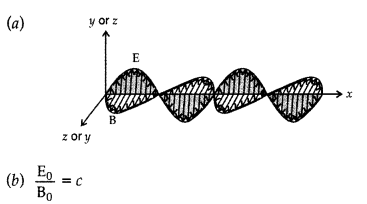
Question 40.
A capacitor, made of two parallel plates each of plate area A and separation d, is being charged by an external ac source. Show that the displacement current inside the capacitor is the same as the current charging the capacitor. (All India 2012)
Answer:
The displacement current arises due to varying electric field![]()
If q be instantaneous charge, then E is electric field between the plates of capacitor at that time and A is area of plate; then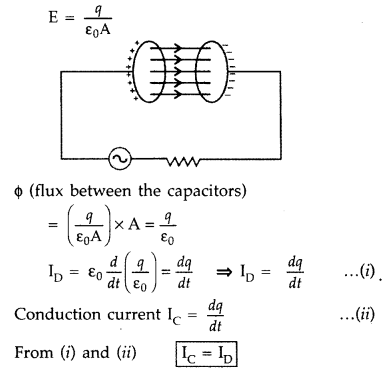
Question 41.
(a) How are electromagnetic waves produced?
(b) How do you convince yourself that electromagnetic waves carry energy and momentum? (Comptt. Delhi 2012)
Answer:
(a) Electromagnetic Waves : Accelerating electric charge produces electromagnetic waves.
(b) Einstein’s explanation of photoelectric effect led de Broglie to the wave-particle duality, i.e., matter exhibits wave as well as particle properties. Electromagnetic waves are characterised by wave properties, such as periodicity in space-time, wavelength, amplitude, frequency, wave velocity etc. It transports energy but no matter.
The term wave-particle duality refers to the behaviour where both wave-like and particle-like properties are exhibited under different conditions by the same entity. Hence electromagnetic waves show particle properties such as definite position, size, mass, velocity, momentum, energy etc.
For a photon of momentum (p), an associated wavelength is given by
Question 42.
(a) Arrange the following electromagnetic waves in the descending order of their wavelengths :
- Microwaves
- Infra-red rays
- Ultra-violet radiation
- Gamma rays
(b) Write one use each of any two of them. (Comptt. Delhi 2013)
Answer:
(a) Arrangement:
- Microwaves
- Infra-red rays
- Ultra-violet radiation
- Gamma rays
(b) Uses :
- Microwaves are used in radar system.
- Infra-red rays are used for protecting dehydrated fruits.
- Ultra-violet rays are used in the study of molecular structure.
- Gamma rays are used to kill micro-organisms in food industry.
Question 43.
Considering the case of a parallel plate capacitor being charged, show how one is required to generalize Ampere’s circuital law to include the term due to displacement current. (All India 2014)
Answer:
Maxwell’s displacement current : According to Ampere’s circuital law, the magnetic field B is related to steady current I as
Maxwell showed that this relation is logically in-consistent. He accounted this inconsistency as follows :
Ampere’s circuital law for loop C1 gives
which is logically inconsistent. So, Maxwell gave idea of displacement current.
Thus displacement current is that current which comes into play in the region in which the electric field and hence the electric flux is changing with time.
It is now called Ampere-Maxwell law. This is the generalization of Ampere’s circuital law.
Question 44.
A capacitor is connected in series to an ammeter across a d.c. source. Why does the ammeter show a momentary deflection during the charging of the capacitor? What would be the deflection when it is fully charged? (Comptt. All India 2014)
Answer:
The momentary deflection is due to the transient current flowing through the circuit when the capacitor is getting charged.
The deflection would be zero when the capacitor gets fully charged.
Question 45.
Name the types of e.m. radiations which
- are used in destroying cancer cells,
- cause tanning of the skin and
- maintain the earth’s warmth.
Write briefly a method of producing any one of these waves. (Delhi 2015)
Answer:
- γ-rays
- Ultraviolet rays
- Infrared rays
Mode of production
- γ-rays are produced by radioactive decay of nucleus.
- Ultraviolet rays are produced when inner shell electrons in atoms move from one energy level to an other energy level.
- Infrared rays are produced due to vibration of atoms and molecules.
Question 46.
For a plane electromagnetic wave, propagating along the Z-axis, write the two (possible) pairs of expression for its oscillating electric and magnetic fields. How are the peak values of these (oscillating) fields related to each other? (Comptt. All India 2016)
Answer:
For the e.m. wave, propagating along the z-axis, we have![]()
The two possible forms for electric and magnetic fields are :![]()
The peak values of these two fields are related by![]()
Question 47.
An e.m. wave, Y1, has a wavelength of 1 cm while another e.m. wave, Y2, has a frequency of 1015 Hz. Name these two types of waves and write one useful application for each. (Comptt. All India 2014)
Answer:
(i) Y1 ➝ Microwaves
Applications : Microwaves are used in Microwave ovens, Aircraft Navigators etc.
(ii) Y2 ➝ Ultraviolet waves
Applications : Ultraviolet rays are used in sterilizing surgical instruments, food preservation etc.
Question 48.
How does Ampere-Maxwell law explain the flow of current through a capacitor when it is being charged by a battery? Write the expression for the displacement current in terms of the rate of change of electric flux. (Delhi 2017)
Answer:
During charging, the electric flux between the plates of a capacitor keeps on changing; this results in the production of a displacement current between the plates.
Question 49.
Identify the electromagnetic waves whose wavelengths vary as
(a) 10-12 < λ < 10-8 m
(b) 10-3 m < X < 10-1 m
Write one use for each. (All India 2017)
Answer:
(a) X-rays—Used in medical science for the purpose of detection of fractures, stones in gall bladder, stones in kidney etc.
(b) Microwaves—Used in radar systems for aircraft navigation.
Question 50.
Identify the electromagnetic waves whose wavelengths lie in the range
(a) 10-11 m < λ < 10-8 m
(b) 10-4 m < λ < 10-6 m Write one use of each. (All India 2017)
Answer:
(a) Uses of X-Rays and Gamma rays :
X-rays are used as a diagnostic tool in medicine and as a treatment for certain forms of cancer. Gamma rays are used in medicine to destroy cancer cells.
(b) Uses of Infrared, visible and microwaves :
- Infrared waves are widely used in remote switches of household electronic systems such as remotes for TVs, video recorders etc.
- Visible rays provide us information about the world.
- Microwaves are used in the radar systems in aircraft navigation.
Question 51.
How is electromagnetic wave produced? Draw a sketch of a plane e.m. wave propagating along X-axis depicting the directions of the oscillating electric and magnetic fields. (Comptt. Delhi 2017)
Answer:
Electromagnetic waves are produced due to oscillating/accelerating charged particles.
Sketch of e.m. wave :
Electromagnetic Waves Class 12 Important Questions Short Answer Type SA-II
Question 52.
Identify the following electromagnetic radiations as per the wavelengths given below. Write one application of each. (All India 2008)
(a) 10-3 nm
(b) 10-3 m
(c) 1 nm
Answer:
(a) 10-3 nm : γ-rays
Application :
- γ-rays are used in the treatment of cancer and tumour.
- γ-rays are used in radiation therapy. (any one)
(b) 10-3m : Microwave
Application : Microwaves are used in Radar systems for aircraft navigation.
(c) 1 nm : X-rays Application :
- Infra-red waves are used for taking photographs during the conditions of fog, smoke etc.
- These are also used as a diagonostic tool for the detection of fractures, (any one)
Question 53.
Identify the following electromagnetic radiations as per the wavelengths given below. Write one application of each.
(a) 1 mm
(b) 10-12 m
(c) 10-8 m (All India 2008)
Answer:
(a) 1 mm : Microwaves
Application : In aircraft navigation for the radar system. Also used in microwave ovens.
(b) 10-12 m : Gamma rays
Application : Gamma rays are used as medicine to destroy cancer cells
(c) 10-8 m : Ultraviolet rays
Application : Ultraviolet rays are used in LASIK eye surgery.
Question 54.
(a) How does an oscillating charge produce electromagnetic wave? Explain.
(b) Draw a sketch showing the propagation of a plane em wave along the Z-direction, clearly depicting the directions of oscillating electric and magnetic field vectors. (Comptt. Delhi 2012)
Answer:
(a) Consider a charge oscillating with same frequency. This produces an oscillating electric field in space, which produces an oscillating magnetic field which in turn is a source of oscillating electric field and so on. The oscillating electric and magnetic fields thus regenerate each other, as the waves propagate through the space. The frequency of the electromagnetic wave naturally equals the frequency of the oscillation of the charge.
(b)
Sketch of a plane electromagnetic wave propagating along the z-direction with oscillating electric field E along the x-direction and the oscillating magnetic field B along the y-direction.
Question 55.
When an ac source is connected across a capacitor, current starts flowing through the circuit. Show how Ampere’s circuital law is generalized to explain the flow of current through the capacitor. Hence obtain the expression for the displacement current inside the capacitor. (Comptt. All India 2012)
Answer:
When an ‘ac’ source is connected across a capacitor, the charge on the capacitor also becomes time dependent. It gives rise to a time dependent electric field between the plates of capacitor. As a result the electric flux changes.
It was suggested that we need to regard this changing electric flux, between the plates of capacitor, as equivalent to a current which is called the displacement current.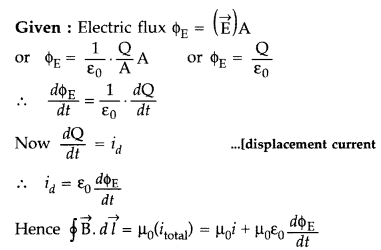
which is generalised form of an Ampere’s circuital law. .
Question 56.
(a) When the oscillating electric and magnetic fields are along the x- and indirection respectively
- point out the direction of propagation . of electromagnetic wave.
- express the velocity of propagation in terms of the amplitudes of the oscillating electric and magnetic fields.
(b) How do you show that the em wave carries energy and momentum?(Comptt. All India)
Answer:
(a)
- Along z-direction.
- Velocity of propogation will be,
C=E0B0
(b) Photoelectric effect shows the particle nature of electromagnetic waves. As such the photons carry energy and momentum. The energy is given by![]()
Question 57.
Answer the following :
(a) Name the em waves which are suitable for radar systems used in aircraft navigation. Write the range of frequency of these waves.
(b) If the. earth did not have atmosphere, would its average surface temperature be higher or lower than what it is now? Explain.
(c) An em wave exerts pressure on the surface on which it is incident. Justify. (Delhi 2014)
Answer:
(a) Microwaves are used in radar systems. Its frequency range : 1010 to 1012 Hz
(b) In the absence of earth’s atmosphere, there would have no ozone layer to prevent ultraviolet radiations reaching the earth, the temperature on earth’s surface would have been lower due to green house effect, making it difficult for human survival.
(c) Since em wave carries both energy and momentum, hence exerts pressure on the surface on which it is incident.
An em wave exerts negligibly very small pressure on the surface on which it is incident.
It is due to the fact that momentum of the photon is extremely small, which can be
calculated by de-Broglie relation 
Question 58.
Answer the following :
(a) Name the em waves which are used for the treatment of certain forms of cancer. Write their frequency range.
(b) Thin ozone layer on top of stratosphere is crucial for human survival. Why?
(c) Why is the amount of the momentum transferred by the em waves incident on the surfrace so small? (Delhi 2014)
Answer:
(a) Gamma (γ) rays are used for the treatment of certain forms of cancer. Their frequency range is 1018 Hz to 1022 Hz.
(b) The thin ozone layer on top of stratosphere absorbs most of the harmful ultraviolet rays coming from the Sun towards the Earth. They include UVA, UVB and UVC radiations, which can destroy the life system on the Earth.
Hence, this layer is crucial for human survival.
(c) Thus, the amount of the momentum transferred by the em waves incident on the surface is very small, because of small value of planks constant. For example, an electromagnetic wave of wavelength 1.00 nm will provide momentum (p) according to de-Broglie’s relation,![]()
It is extremely small value of the momentum.
Question 59.
Answer the following questions :
(a) Name the em waves which are produced during radioactive decay of a nucleus. Write their frequency range.
(b) Welders wear special glass goggles while working. Why? Explain.
(c) Why are infrared waves often called as heat waves? Give their one application. (Delhi 2014)
Answer:
(a) γ-rays; Frequency range : 1018 Hz to 1022 Hz
(b) Because to protect eyes from intense ultra-violet radiations produced during welding; and also to protect from glare and flying sparks.
(c) Because infrared waves are em waves of higher wavelength (less frequency) and are produced by highly vibrating molecules of hot bodies.
Applications :
- used in the remote switches of household electronic systems.
- used for protecting dehydrated fruits.
- used in solar water heaters and cookers. (Any one)
Question 60.
Answer the following questions:
(i) Show, by giving a simple example, how em waves carry energy and momentum.
(i) How are microwaves produced? Why is it necessary in microwave ovens to select the frequency of microwaves to match the resonant frequency of water molecules?
(iii) Write two important uses of infrared waves. (Comptt. Delhi 2014)
Answer:
(i) Consider a plane perpendicular to the direction of propagation of the wave. An electric charge, on the plane, will be set in motion by the electric and magnetic fields of em wave, incident on this plane. This illustrates that em waves carry energy and momentum.
(ii) Microwaves are produced by special vacuum tubes like the Klystron/Magnetron/Gunn diode.
In microwave ovens, the frequency of microwaves is selected to match the resonant frequency of water molecules, so that energy is transferred efficiently to the kinetic energy of the molecules.
(iii) Important uses of infra-red waves :
1. These are associated with the green house effect.
2. These are used in remote switches of household electrical appliances.
Question 61.
(a) A capacitor is connected in series to an ammeter across a d.c. source. Why does the ammeter show a momentary deflection during the charging of the capacitor? What would be the deflection when it is fully charged?
(b) How is the generalized form of Ampere’s circuital law obtained to include the term due to displacement current? (Comptt. All India 2014)
Answer:
(a) The momentary deflection is due to the transient current flowing through the circuit when the capacitor is getting charged.
The deflection would be zero when the capacitor gets fully charged.
(b)
Maxwell’s displacement current : According to Ampere’s circuital law, the magnetic field B is related to steady current I as
Maxwell showed that this relation is logically in-consistent. He accounted this inconsistency as follows :
Ampere’s circuital law for loop C1 gives
which is logically inconsistent. So, Maxwell gave idea of displacement current.
Thus displacement current is that current which comes into play in the region in which the electric field and hence the electric flux is changing with time.
It is now called Ampere-Maxwell law. This is the generalization of Ampere’s circuital law
Question 62.
Name the parts of the electromagnetic spectrum which is
(a) suitable for radar systems used in aircraft navigation.
(b) used to treat muscular strain.
(c) used as a diagnostic tool in medicine.
Write in brief, how these waves can be produced. (Delhi 2014)
Answer:
(a) Microwaves
Production : Klystron/magnetron
(b) Infrared Radiations
Production ; Hot bodies/vibrations of atoms and molecules.
(c) X-Rays
Production : Bombarding high energy electrons on a metal target.
Question 63.
Write the expression for the generalized form of Ampere’s circuital law. Discuss its significance and describe briefly how the concept of displacement current is explained through charging/discharging of a capacitor in an electric circuit. (All India 2014)
Answer:
Maxwell’s displacement current : According to Ampere’s circuital law, the magnetic field B is related to steady current I as![]()
Maxwell showed that this relation is logically inconsistent. He accounted this inconsistency as follows :
Ampere’s circuital law for loop C1 gives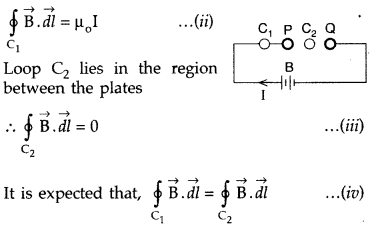
which is logically inconsistent. So, Maxwell gave idea of displacement current.
Thus displacement current is that current which comes into play in the region in which the electric field and hence the electric flux is changing with time.
It is now called Ampere-Maxwell law. This is the generalization of Ampere’s Circuital law.
Question 64.
How are em waves produced by oscillating charges?
Draw a sketch of linearly polarized em waves propagating in the Z-direction. Indicate the directions of the oscillating electric and magnetic fields. (Delhi 2016)
Answer:
em waves by oscillating charges.
(a) Consider a charge oscillating with same frequency. This produces an oscillating electric field in space, which produces an oscillating magnetic field which in turn is a source of oscillating electric field and so on. The oscillating electric and magnetic fields thus regenerate each other, as the waves propagate through the space. The frequency of the electromagnetic wave naturally equals the frequency of the oscillation of the charge.
(b)
Sketch of a plane electromagnetic wave propagating along the z-direction with oscillating electric field E along the x-direction and the oscillating magnetic field B along the y-direction.
Sketch of em waves.
Sketch of a plane electromagnetic wave propagating along the z-direction with oscillating electric field E along the x-direction and the oscillating magnetic field B along the y-direction.
Question 65.
Write Maxwell’s generalization of Ampere’s Circuital Law. Show that in the process of charging a capacitor, the current produced within the plates of the capacitor is![]()
where ϕ E is electric flux produced during charging of the capacitor plates. (Delhi 2016)
Answer:
Maxwell’s displacement current : According to Ampere’s circuital law, the magnetic field B is related to steady current I as
Maxwell showed that this relation is logically in-consistent. He accounted this inconsistency as follows :
Ampere’s circuital law for loop C1 gives
which is logically inconsistent. So, Maxwell gave idea of displacement current.
Thus displacement current is that current which comes into play in the region in which the electric field and hence the electric flux is changing with time.
It is now called Ampere-Maxwell law. This is the generalization of Ampere’s circuital law.
Question 66.
(i) Identify the part of the electromagnetic spectrum which is :
(a) suitable for radar system used in aircraft navigation,
(b) produced by bombarding a metal target by high speed electrons.
(ii) Why does a galvanometer show a momentary deflection at the time of charging or discharging a capacitor? Write the necessary expression to explain this observation. (All India 2016)
Answer:
(i)
(a) Microwaves
(b) X-rays
(ii) The total current
(i) is the sum of conduction current
(ic) and displacement current (id), so we have![]()
This means that outside the capacitor plates in connecting wires, we have only conduction current ic = i and no displacement current (id = 0). On the other hand, inside the capacitor, there is no conduction current (ic = 0) and there is only displacement current hence i = id.
It is why there is momentary deflection in the galvanometer at the time of charging or discharging a capacitor.
Question 67.
Name the e.m. waves in the wavelength range 10 nm to 10-3 nm. How are these waves generated? Write their two uses. (Comptt. All India 2017)
Answer:
- e.m. waves in the wavelength range 10 nm to 10-3 nm are X-rays.
- X-rays are generated by bombarding a metal target with high energy electrons.
• Uses :
- Diagnosis of bone fractures.
- Treatment of some forms of cancer.
Question 68.
Name the type of e.m. waves having a wavelength range of 0.1 m to 1 mm. How are these waves generated? Write their two uses. (Comptt. All India 2017)
Answer:
- e.m. waves having a wavelength range 0.1 m to 1 mm are MICROWAVES.
- Microwaves are generated by special vacuum tubes such as klystron, magnetron and gunn diodes.
- Microwaves are used in :
- Radar system in aircraft navigation
- Ovens for heating and cooking.
Question 69.
Name the type of e.m. waves having a wavelength range 10-7 m to 10-9 m. How are these waves generated? Write their two uses. (Comptt. All India 2017)
Answer:
- e.m. waves having a wavelength range 10-7 m to 10-9 m are ultra violet rays.
- Sun is an important source of UV rays. Some special lamps and very hot bodies also produce UV rays.
• Uses :
- UV rays are used in lasik eye surgery.
- UV lamps are being used to kill germs in water purifiers.










